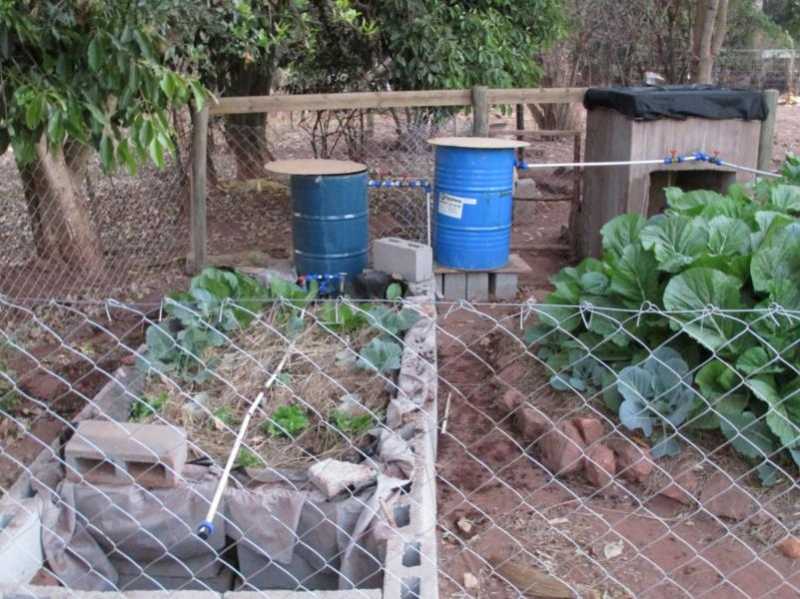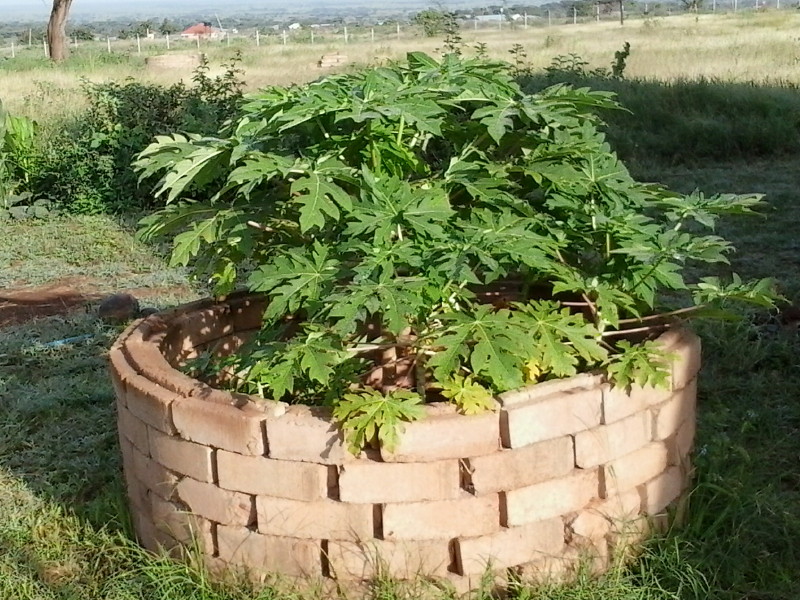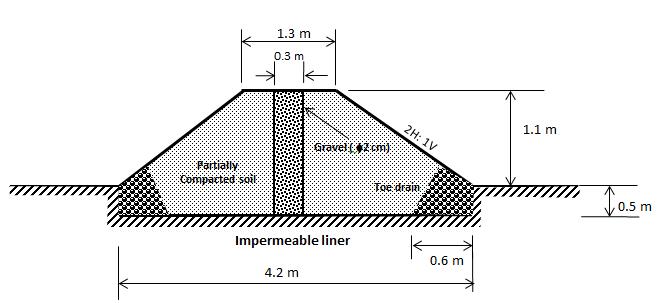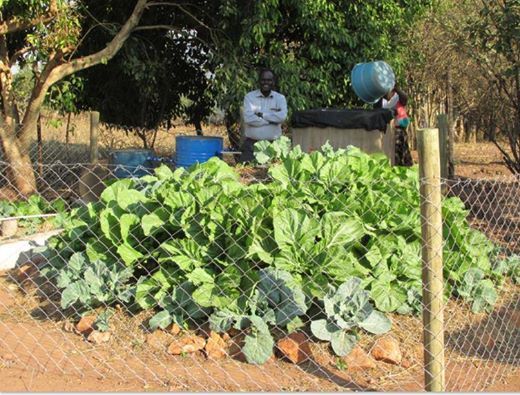- Forum
- categories
- Resource recovery
- Greywater, blackwater or wastewater reuse, irrigation
- A grey water dam for the treatment and reuse of grey water for single and multiple households
A grey water dam for the treatment and reuse of grey water for single and multiple households
21.3k views
Re: A grey water dam for the treatment and reuse of grey water for single and multiple households
Ababu:
An interesting observation. I'd rather think it's because of microbial growth rather than organics coming in with the grey water. But there would certainly be nutrients coming in with the water. One thing I noticed is that some of the locally manufactured detergents are still containing phosphates here in Uganda - it's written on the list of ingredients of some of the washing powders. That would usually not be the case in developed countries. But nutrients, water and air would spur the growth of micro-organisms.
Greetings, H-A
An interesting observation. I'd rather think it's because of microbial growth rather than organics coming in with the grey water. But there would certainly be nutrients coming in with the water. One thing I noticed is that some of the locally manufactured detergents are still containing phosphates here in Uganda - it's written on the list of ingredients of some of the washing powders. That would usually not be the case in developed countries. But nutrients, water and air would spur the growth of micro-organisms.
Greetings, H-A
Hanns-Andre Pitot
M.Eng. Environmental Pollution Control
presently in Seesen, Germany
M.Eng. Environmental Pollution Control
presently in Seesen, Germany
Please Log in to join the conversation.
You need to login to reply- former member
-
Topic AuthorLess
- Posts: 101
- Likes received: 3
Re: A grey water dam for the treatment and reuse of grey water for single and multiple households
Dear HA
Thanks again for your information which added to my perspective of grey water reuse. The growth is visible. One thing I have observed is grey water can turn an infertile soil into a fertile compost. This is especially visible from the other pilot plant we built. This is a multi-step filter followed by horizontal flow planted filter for grey water disposal. The soil following grey water flow through it is now rich in organics. I have attached the photo of the plant.
++++++++
Note by moderators: This post was made by a former user with the login name Ababu who is no longer a member of this discussion forum.
Thanks again for your information which added to my perspective of grey water reuse. The growth is visible. One thing I have observed is grey water can turn an infertile soil into a fertile compost. This is especially visible from the other pilot plant we built. This is a multi-step filter followed by horizontal flow planted filter for grey water disposal. The soil following grey water flow through it is now rich in organics. I have attached the photo of the plant.
++++++++
Note by moderators: This post was made by a former user with the login name Ababu who is no longer a member of this discussion forum.
Attachments:
-
 Grey_water...na_3.jpg
(Filesize: 67KB)
Grey_water...na_3.jpg
(Filesize: 67KB)
Please Log in to join the conversation.
You need to login to replyRe: A grey water dam for the treatment and reuse of grey water for single and multiple households
Hello Ababu,
thanks again for you interest! It would be great if you could further investigate my idea! And keep us posted about how your research is going!
In the meantime, I made some new photos of my 'waste water garden' - please see below! The papaya trees have grown a lot since the last photos were taken, and they are flowering. And now, you can see the waste water pipe coming into the depression in the middle. You can also see a young tomato plant growing in that basin - it has certainly come as a seed with the water.
Kind regards, and success with your research!
H-A
thanks again for you interest! It would be great if you could further investigate my idea! And keep us posted about how your research is going!
In the meantime, I made some new photos of my 'waste water garden' - please see below! The papaya trees have grown a lot since the last photos were taken, and they are flowering. And now, you can see the waste water pipe coming into the depression in the middle. You can also see a young tomato plant growing in that basin - it has certainly come as a seed with the water.
Kind regards, and success with your research!
H-A
Hanns-Andre Pitot
M.Eng. Environmental Pollution Control
presently in Seesen, Germany
M.Eng. Environmental Pollution Control
presently in Seesen, Germany
Attachments:
-
 20140812_081155_1.jpg
(Filesize: 214KB)
20140812_081155_1.jpg
(Filesize: 214KB)
-
 20140812_081729_1.jpg
(Filesize: 180KB)
20140812_081729_1.jpg
(Filesize: 180KB)
Please Log in to join the conversation.
You need to login to reply- former member
-
Topic AuthorLess
- Posts: 101
- Likes received: 3
Re: A grey water dam for the treatment and reuse of grey water for single and multiple households
Dear H.A.
Thanks for the clarification and i can see that. Now it is clear and I seem to understand it. The maintenance is simple (manageable). Usually dirt accumulates on surface in finer media such as soil and can be handled from the surface. In the grey water dam we made also sure that we do not put too much impermeable material that impedes flow of water and the manure mixture helps although we used mild compaction to stabilize the soil and discourage soil piping problem. The reuse of grey water by segregation is interesting idea. Your approach is some thing worth trying in our project.
Best regards
Ababu.
++++++++
Note by moderators: This post was made by a former user with the login name Ababu who is no longer a member of this discussion forum.
Thanks for the clarification and i can see that. Now it is clear and I seem to understand it. The maintenance is simple (manageable). Usually dirt accumulates on surface in finer media such as soil and can be handled from the surface. In the grey water dam we made also sure that we do not put too much impermeable material that impedes flow of water and the manure mixture helps although we used mild compaction to stabilize the soil and discourage soil piping problem. The reuse of grey water by segregation is interesting idea. Your approach is some thing worth trying in our project.
Best regards
Ababu.
++++++++
Note by moderators: This post was made by a former user with the login name Ababu who is no longer a member of this discussion forum.
Please Log in to join the conversation.
You need to login to replyRe: A grey water dam for the treatment and reuse of grey water for single and multiple households
Hello Ababu,
Thanks for your interest. The water from the kitchen sink is directed via a 1.5 inch PVC pipe into the depression you see in the 2nd photo. It comes out where you see the small stones in the circle. Dirt is carried all the way to that point (if it has not already been captured in the siphon in the kitchen). So, if too much silt has accumulated, you need to scoop it out and remodel the circular depression around the tree - a work of 10 minutes.
Concerning clogging or water logging - I have never experienced it. But as I was saying, I made sure to excavate a planting hole which is a bit deep (at least 0.6 m), and to refill it with some of the excavated stones at the bottom (the soil here is very stony) and a mix of the soil and compost above. The soil here is a claiy, sandy loam.
But the idea would be to have a separate disposal area for each point source of gray water - so my shower room could feed into a separate area that could be planted with bananas, for example. I am saying 'could' because it's already connected to the septic tank. So, it's a decentralized disposal that would favor a lot of fruit trees and possibly other crops (green peppers?) that are planted around the circular depressions in the middle.
Hope that answers your questions. And may-be, there are others who have experience with such irrigation areas and could report about their experiences?
Kind regards, H-A
Thanks for your interest. The water from the kitchen sink is directed via a 1.5 inch PVC pipe into the depression you see in the 2nd photo. It comes out where you see the small stones in the circle. Dirt is carried all the way to that point (if it has not already been captured in the siphon in the kitchen). So, if too much silt has accumulated, you need to scoop it out and remodel the circular depression around the tree - a work of 10 minutes.
Concerning clogging or water logging - I have never experienced it. But as I was saying, I made sure to excavate a planting hole which is a bit deep (at least 0.6 m), and to refill it with some of the excavated stones at the bottom (the soil here is very stony) and a mix of the soil and compost above. The soil here is a claiy, sandy loam.
But the idea would be to have a separate disposal area for each point source of gray water - so my shower room could feed into a separate area that could be planted with bananas, for example. I am saying 'could' because it's already connected to the septic tank. So, it's a decentralized disposal that would favor a lot of fruit trees and possibly other crops (green peppers?) that are planted around the circular depressions in the middle.
Hope that answers your questions. And may-be, there are others who have experience with such irrigation areas and could report about their experiences?
Kind regards, H-A
Hanns-Andre Pitot
M.Eng. Environmental Pollution Control
presently in Seesen, Germany
M.Eng. Environmental Pollution Control
presently in Seesen, Germany
Please Log in to join the conversation.
You need to login to reply- former member
-
Topic AuthorLess
- Posts: 101
- Likes received: 3
Re: A grey water dam for the treatment and reuse of grey water for single and multiple households
Dear HA
Thanks for your reply and for providing the photos which really are interesting varieties. I am sure there are people who might rather prefer your approach and it is good to keep broader perspective of possible choices for the community. I agree Some level of control is needed if it can be practiced with regard to detergents and other pollutants that may end up in the grey water if the grey water had to be reused like this. But i have a question if you can tell me some more detail to clear my confusion as to how you direct the grey water into the planting area? It looks like the grey water now does not come from the septic tank (is separated from black water). At what level does it enter the tree area? How do you deal with clogging and water saturation?
++++++++
Note by moderators: This post was made by a former user with the login name Ababu who is no longer a member of this discussion forum.
Thanks for your reply and for providing the photos which really are interesting varieties. I am sure there are people who might rather prefer your approach and it is good to keep broader perspective of possible choices for the community. I agree Some level of control is needed if it can be practiced with regard to detergents and other pollutants that may end up in the grey water if the grey water had to be reused like this. But i have a question if you can tell me some more detail to clear my confusion as to how you direct the grey water into the planting area? It looks like the grey water now does not come from the septic tank (is separated from black water). At what level does it enter the tree area? How do you deal with clogging and water saturation?
++++++++
Note by moderators: This post was made by a former user with the login name Ababu who is no longer a member of this discussion forum.
Please Log in to join the conversation.
You need to login to replyRe: A grey water dam for the treatment and reuse of grey water for single and multiple households
Dear Ababu, dear all,
Interesting design you have presented there - looks like a combination of a soak pit and a key hole garden. Of course, fruit trees can also be irrigated very successfully using grey water, and there is not much of an issue when it comes to pathogens.
I have been using kitchen waste water in order to irrigate some papaya trees in my garden here in Moroto, Uganda - see the attached photos. It's a house which is connected to a septic tank system, but when I had a kitchen sink installed into my kitchen, I decided not to connect it to the septic tank and to use the waste water in order to irrigate some papaya trees. I am seeing it as an alternative, groundwater friendly way of disposing of the waste water.
The water from the kitchen is discharged into what has originally been a large planting hole for the trees filled with soil and (ecosan derived) compost. The water is going into a circular depression in the centre and from there, it is seeping into the rooting zone of the trees. It has so far been working very well, and has allowed me to grow papaya trees where they would have otherwise not grown without significant use of water during the dry season of several months in this region. One of the trees is planted - the larger one in the middle, the others have come out by themselves from the compost.
Of course, in this case, it is an isolated incidence of such an installation, but I believe that designs like this could be used in large numbers in a town setting, and could also be used to dispose of the water of shower rooms and other grey water, inclusive of some urine if the shower rooms are used as urinals. In that case, I would, however, plant banana trees in addition of popos because of their high demand for water and nutrients.
The other issue would be to avoid detergents that are not biodegradable - an information that is usually very difficult to get from the manufacturers. So far, my papaya trees have taken it well (i.e. dish washing liquid, in particular).
Kind regards to everybody,
H-A
Interesting design you have presented there - looks like a combination of a soak pit and a key hole garden. Of course, fruit trees can also be irrigated very successfully using grey water, and there is not much of an issue when it comes to pathogens.
I have been using kitchen waste water in order to irrigate some papaya trees in my garden here in Moroto, Uganda - see the attached photos. It's a house which is connected to a septic tank system, but when I had a kitchen sink installed into my kitchen, I decided not to connect it to the septic tank and to use the waste water in order to irrigate some papaya trees. I am seeing it as an alternative, groundwater friendly way of disposing of the waste water.
The water from the kitchen is discharged into what has originally been a large planting hole for the trees filled with soil and (ecosan derived) compost. The water is going into a circular depression in the centre and from there, it is seeping into the rooting zone of the trees. It has so far been working very well, and has allowed me to grow papaya trees where they would have otherwise not grown without significant use of water during the dry season of several months in this region. One of the trees is planted - the larger one in the middle, the others have come out by themselves from the compost.
Of course, in this case, it is an isolated incidence of such an installation, but I believe that designs like this could be used in large numbers in a town setting, and could also be used to dispose of the water of shower rooms and other grey water, inclusive of some urine if the shower rooms are used as urinals. In that case, I would, however, plant banana trees in addition of popos because of their high demand for water and nutrients.
The other issue would be to avoid detergents that are not biodegradable - an information that is usually very difficult to get from the manufacturers. So far, my papaya trees have taken it well (i.e. dish washing liquid, in particular).
Kind regards to everybody,
H-A
Hanns-Andre Pitot
M.Eng. Environmental Pollution Control
presently in Seesen, Germany
M.Eng. Environmental Pollution Control
presently in Seesen, Germany
Attachments:
-
 20140517_0..._2_1.jpg
(Filesize: 66KB)
20140517_0..._2_1.jpg
(Filesize: 66KB)
-
 20140517_0..._2_1.jpg
(Filesize: 75KB)
20140517_0..._2_1.jpg
(Filesize: 75KB)
Please Log in to join the conversation.
You need to login to reply- former member
-
Topic AuthorLess
- Posts: 101
- Likes received: 3
Re: A grey water dam for the treatment nd resue of grey water for single and multiple households
Sebastian:
Thank you for your interest on this work. The grey water as generated from the households here excludes urine and fecal waste. The households use yard tap connection and the grey water generated from laundary, food preparation, bathing, etc is naturally segregated and is thrown into the yard area. For the momemnt we did not use extensive pre-treatment. Our pretreatment worry is the solids from the grey water that may cause clogging. For the moment used only fine gravel preceded by cloth sieve. in future we will consider a more extensive pretreatment with possible objectives including pathogen removal as a multiple barrier component. There is no "standard" in Swaziland regarding the safety of grey water reuse for agriculture. The WHO guideline is the only document that is available. For now we depend on the ability of the soil treatment to filter pathogens and to a certain extent the ash mixed with the soil may also help in removal of pathogens. But as it is there this is a risk that we will want to explore and evaluate in our research. I have attached an approximate sectional sketch of the grey water dam.
++++++++
Note by moderators: This post was made by a former user with the login name Ababu who is no longer a member of this discussion forum.
Thank you for your interest on this work. The grey water as generated from the households here excludes urine and fecal waste. The households use yard tap connection and the grey water generated from laundary, food preparation, bathing, etc is naturally segregated and is thrown into the yard area. For the momemnt we did not use extensive pre-treatment. Our pretreatment worry is the solids from the grey water that may cause clogging. For the moment used only fine gravel preceded by cloth sieve. in future we will consider a more extensive pretreatment with possible objectives including pathogen removal as a multiple barrier component. There is no "standard" in Swaziland regarding the safety of grey water reuse for agriculture. The WHO guideline is the only document that is available. For now we depend on the ability of the soil treatment to filter pathogens and to a certain extent the ash mixed with the soil may also help in removal of pathogens. But as it is there this is a risk that we will want to explore and evaluate in our research. I have attached an approximate sectional sketch of the grey water dam.
++++++++
Note by moderators: This post was made by a former user with the login name Ababu who is no longer a member of this discussion forum.
Attachments:
-
 Grey_water...jpeg.jpg
(Filesize: 36KB)
Grey_water...jpeg.jpg
(Filesize: 36KB)
The following user(s) like this post: HAPitot
Please Log in to join the conversation.
You need to login to reply- sebastian
-

- User is blocked
Less- Posts: 3
- Karma: 1
- Likes received: 2
Re: A grey water dam for the treatment nd resue of grey water for single and multiple households
Hi Ababu,
I am Sebastian, currently working as an intern at GIZ in sustainable sanitation.
Your project is really interesting, as it makes use of nutrients directly on site. I personally believe in those local and decentralized solutions using materials that are mostly readily available.
First, I would like to ask about your terms: I use grey water for kitchen sink and shower effluents. Does your grey water also contain urine or fecal matter? What is the per-treatment in your system doing?
Secondly, could you tell us more about the safety standards for using grey water on food crops?
Also, I would be interested in a more detailed explanation of your design. Do you have a sketch drawing that shows the different elements?
Have a wonderful weekend,
Sebastian
I am Sebastian, currently working as an intern at GIZ in sustainable sanitation.
Your project is really interesting, as it makes use of nutrients directly on site. I personally believe in those local and decentralized solutions using materials that are mostly readily available.
First, I would like to ask about your terms: I use grey water for kitchen sink and shower effluents. Does your grey water also contain urine or fecal matter? What is the per-treatment in your system doing?
Secondly, could you tell us more about the safety standards for using grey water on food crops?
Also, I would be interested in a more detailed explanation of your design. Do you have a sketch drawing that shows the different elements?
Have a wonderful weekend,
Sebastian
Sebastian Klos
KC Wasser, "Sustainable Sanitation" Programme
Sustainable Sanitation Alliance (SuSanA) Secretariat
Intern
Deutsche Gesellschaft für
Internationale Zusammenarbeit (GIZ) GmbH
Postfach 5180
65726 Eschborn, Deutschland
KC Wasser, "Sustainable Sanitation" Programme
Sustainable Sanitation Alliance (SuSanA) Secretariat
Intern
Deutsche Gesellschaft für
Internationale Zusammenarbeit (GIZ) GmbH
Postfach 5180
65726 Eschborn, Deutschland
The following user(s) like this post: fppirco
Please Log in to join the conversation.
You need to login to reply- former member
-
Topic AuthorLess
- Posts: 101
- Likes received: 3
A grey water dam for the treatment and reuse of grey water for single and multiple households
I am a researcher from the University of Swaziland currently working also as technical expert in the Mbabane Dry Sanitation and waste Management Project. We have developed a grey water dam for the treatment and reuse of grey water something which is an outgrowth of the grey water tower.Grey water after pretreatment enters the central column which is gravel and flows out through the soil dam which is a mixture of manure, soil and ash. A toe drain is placed at the bottom to keep the phreatic line below the surface. A hydraulic equation has been developed to determine the seepage line and determine the height, length of the dam, width of the central gravel column and dimensions of the toe drain. I have attached the experimental pilot photo of the grey water dam in which the vegetables grow well. The dam currently accepts grey water from 5 households but our seepage test indicated it can take up to 2000 liters per day. The detention time as calculated with excess volume available is approximately 5 days.
Ababu T. Tiruneh (PhD)
Lecturer, water resources engineering and the environment
University of Swaziland
++++++++
Note by moderators: This post was made by a former user with the login name Ababu who is no longer a member of this discussion forum.
Ababu T. Tiruneh (PhD)
Lecturer, water resources engineering and the environment
University of Swaziland
++++++++
Note by moderators: This post was made by a former user with the login name Ababu who is no longer a member of this discussion forum.
Attachments:
-
 Grey_water_Dam.jpg
(Filesize: 72KB)
Grey_water_Dam.jpg
(Filesize: 72KB)
The following user(s) like this post: canaday, sebastian
Please Log in to join the conversation.
You need to login to reply
Share this thread:
- Forum
- categories
- Resource recovery
- Greywater, blackwater or wastewater reuse, irrigation
- A grey water dam for the treatment and reuse of grey water for single and multiple households
Recently active users. Who else has been active?
Time to create page: 0.375 seconds








